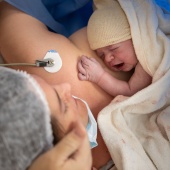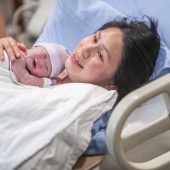Depending on individual circumstances and the reason for the previous caesarean, it is possible to choose between a repeat caesarean or a vaginal birth after a caesarean birth. We discuss the options below.
A vaginal birth after a caesarean birth is known as VBAC.
A planned repeat caesarean birth is known as ERCS (elective repeat caesarean section).
Which one is right for me?
When exploring options, the pregnant woman or person can consider (RCOG, 2016):
- The reason for the previous caesarean
- Whether there were complications during the previous birth or recovery
- Whether they have previously had a vaginal birth
- Whether the current pregnancy is straightforward
- If they plan to have any more children after this one
They might also want to include feelings about the previous birth, and care of other children during the birth and recovery period.
Pregnant women and people can discuss their options at their antenatal appointments. It helps the healthcare team if this happens before 28 weeks of pregnancy. However, the conversation can take place at any time, up to and including the start of labour (RCOG, 2016).
Our NCT antenatal courses give you evidence-based information on all types of birth.
Is it safe to have a vaginal birth after a caesarean?
For most pregnant women and people, having a vaginal birth after a caesarean birth is as safe as having a first vaginal birth. It also has fewer complications than ERCS.
After one pregnancy and caesarean birth, if labour starts spontaneously 3 out of 4 women with a healthy pregnancy will give birth vaginally (RCOG, 2016).
For those who have ever given birth vaginally, 9 in 10 will have a successful VBAC (RCOG, 2016).
When would VBAC not be advised?
A vaginal birth after a previous caesarean is not recommended (RCOG 2016):
- After three or more caesarean births
- Following a tear in the wall of the womb (a uterine rupture) at a previous birth
- After a vertical cut caesarean (where the uterus is cut vertically rather than the usual horizontal cut)
- If other pregnancy complications indicate a caesarean birth would be better
Will extra medical care be offered during a VBAC?
During a VBAC labour: (NICE, 2021; RCOG, 2016)
- It will be recommended to labour in a hospital with immediate access to blood transfusion and caesarean birth
- Let caregivers know as soon as labour starts or the waters break
- Electronic monitoring of the baby will be offered throughout labour.
What are the benefits of VBAC? (RCOG, 2016)
- Shorter recovery time after the birth
- Future births are less complicated following a vaginal birth after a caesarean. They also have fewer risks for the mother or birthing person and baby.
What are the risks of VBAC? (RCOG, 2016; NICE, 2021)
- 1 in 4 people planning VBAC will have an unplanned caesarean birth. This compares with 1 in 5 if labouring for the first time. This is usually because labour has slowed or there are concerns for the labouring parent or baby. An unplanned caesarean has more risks than a planned caesarean.
- A possibility (1 in 200) of the scar on the womb separating or tearing, which increases if labour is induced. This will lead to an emergency caesarean. It is rare for there to be serious consequences.
- If labour isn’t progressing, vaginal birth may be assisted with forceps or ventouse. In this situation there is a higher chance of a third- or fourth-degree tear.
What happens if a VBAC is planned but labour doesn’t start?
If labour hasn’t started by 41 weeks, the doctor will discuss birth options with the mother or birthing person. These will include waiting for labour to start, inducing labour or ERCS (RCOG, 2016).
Is it safe to have a planned caesarean birth after a caesarean (ERCS)?
A planned caesarean after a previous caesarean (ERCS) is also possible.
ERCS is usually planned after 39 weeks of pregnancy, to give the baby as long as possible to develop. Most parents who have a repeat caesarean birth recover well and have healthy babies (RCOG, 2016).
Since there is a higher risk with each caesarean birth, parents should consider how many children they would like. If they are planning to have more children, RCOG say that planning a vaginal birth might be a better option (RCOG, 2016).
Benefits of planning ERCS (RCOG, 2016)
- Lower chance of the uterine scar rupturing (1 in 1000)
- Avoids the rare risks of labour (2 in 1000)
- Reduces the chance of an emergency caesarean birth.
Risks of ERCS (RCOG, 2016)
In addition to the risks of a first caesarean:
- Scar tissue from the first caesarean can make the operation more difficult, and result in damage to the bladder or bowel
- It makes future pregnancies more complicated. It is more likely to mean a planned caesarean in future births, because of the increased chance of the placenta growing into the scar.
What happens if ERCS is planned but labour begins?
If labour starts before a planned ERCS, tell the maternity team. It is likely the caesarean will be offered. If labour has progressed quickly a vaginal birth might be safest (RCOG, 2016).
What are my rights?
There may be a specialist midwife who supports those who are considering options after caesarean birth. If there is no specialist, ask if it is possible to speak to a senior midwife or consultant midwife.
Their role is to provide information to support decision making. This could be for a vaginal birth or a caesarean birth. Whatever choice is made should be supported.
If the pregnant woman or parent isn’t happy with the diagnosis or treatment they receive, they can ask for a second opinion. Asking for a second opinion shouldn’t negatively impact their care (The Patients Association, no date).
NICE (2021) Caesarean birth [NG192] https://www.nice.org.uk/guidance/ng192 [14 Nov 24]
RCOG (2016) Birth after previous caesarean. https://www.rcog.org.uk/for-the-public/browse-our-patient-information/b… [14 Nov 24]
The Patients Association (No date) Getting a second opinion. https://www.patients-association.org.uk/getting-a-second-opinion [14 Nov 24]






